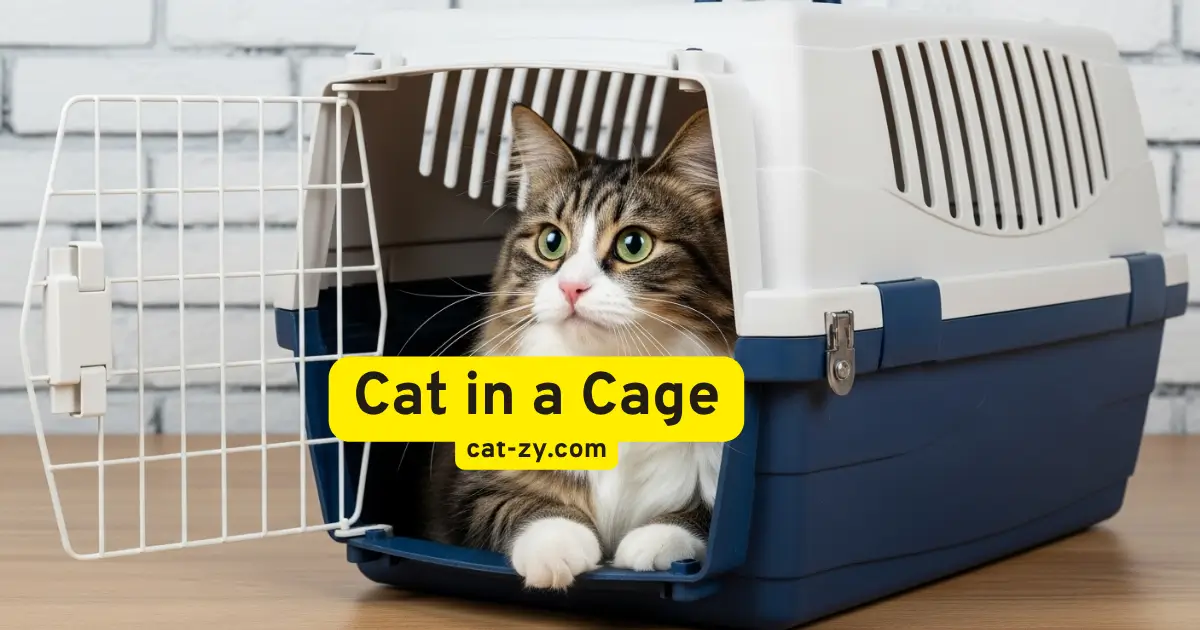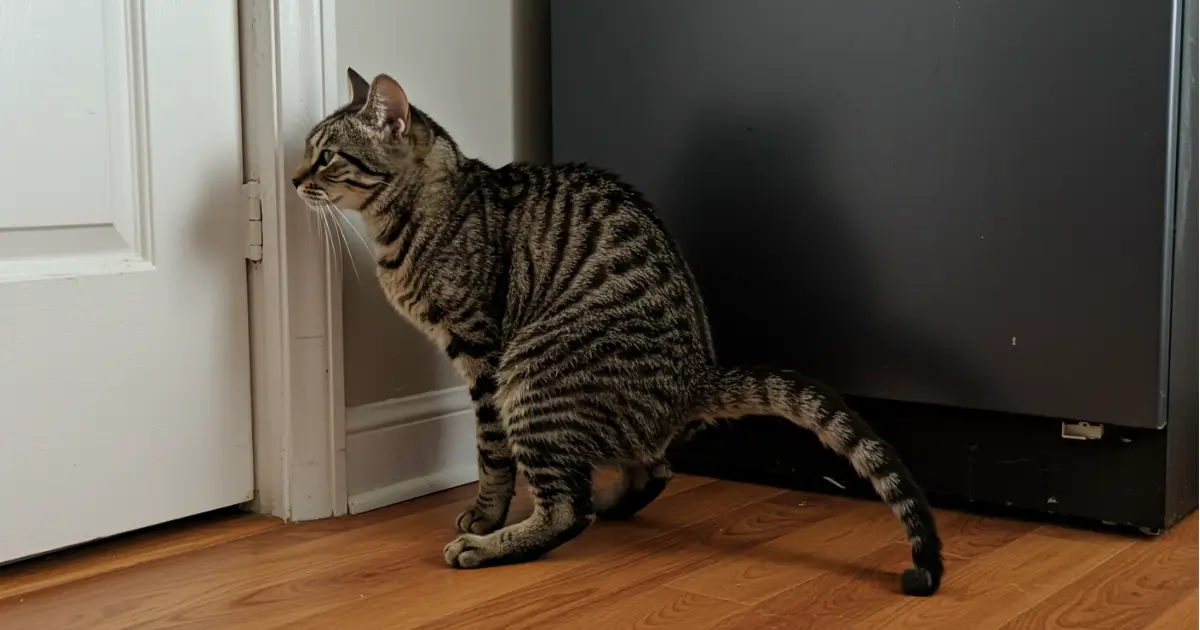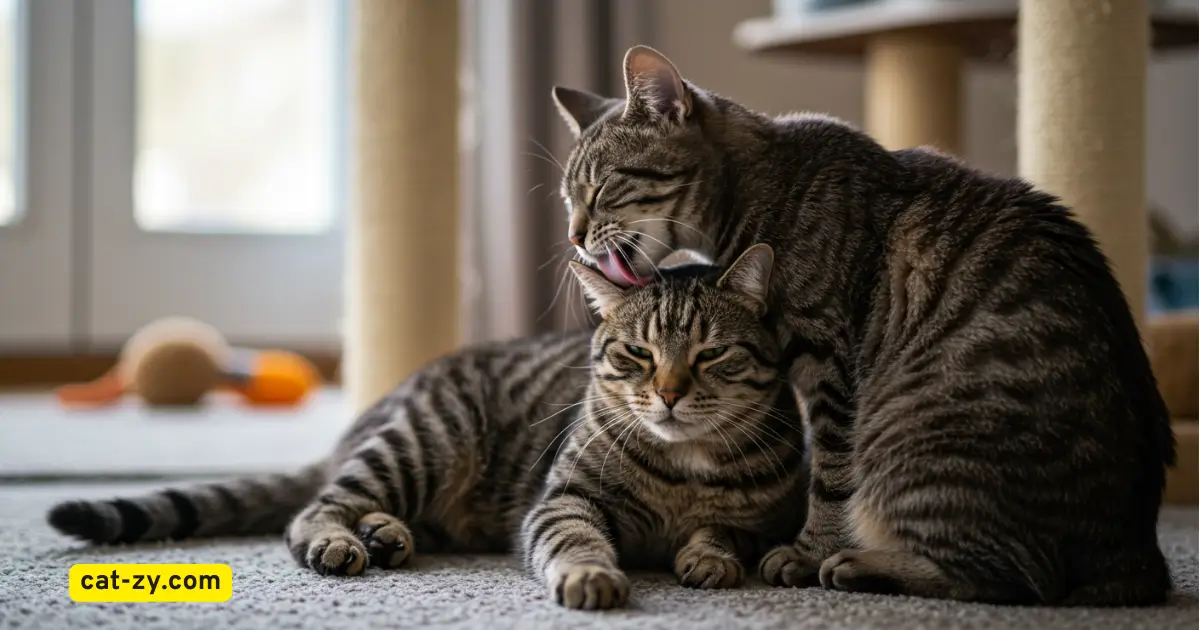Cat in a Cage: 4 Surprising Benefits You Never Considered
As a cat owner, you always want the best for your pet. You look for ways to make them happy and safe. One idea is to keep your cat in a cage for containment. This might seem like a limit, but it has some surprising benefits.
Keeping your pet in can protect them from dangers like traffic, other animals, or harmful substances. This is great for curious pets that love to explore.
There are many benefits to keeping your pet contained. It keeps them safe and can help with training and reducing stress. In this article, we’ll look at four surprising advantages of keeping your pet contained. We’ll see how it can make them happier and healthier.
Table of Contents
Why People Consider Keeping a Cat in a Cage
Keeping a cat in a cage might seem like it limits their freedom. Yet, keeping a cat in a cage serves many practical purposes. It helps cat owners balance their pet’s freedom with safety and health needs.
Common Situations That May Require Temporary Containment
There are times when cat owners must consider keeping their pets in a cage. For example, introducing a new cat to a home can be stressful. cat in a cage methods helps reduce stress and prevents fights with other pets.
When a cat is recovering from surgery or illness, it’s important to limit their movement. Temporary containment is also useful during travel or when keeping your cat away from dangerous situations.
The Difference Between Caging and Crating
cat in a cage methods and crating both involve confining a cat, but they differ. Crating uses a smaller, enclosed space for short-term use, like travel or training. Caging, however, can mean a larger enclosure for longer periods.
Knowing the difference helps choose the best option for your cat’s needs.
The Evolution of Cat Containment Practices
Cat caging has changed a lot over time. This change shows how our views on cats have shifted. Now, we know more about what makes cats happy and healthy.
Traditional Views on Cat Freedom
Older views said cats need to roam free. People thought caging was bad for them. But now, we see that cat in a cage methods can be good in certain situations.
Modern Approaches to Temporary Containment
Today, we know caging is okay for some reasons. It’s good for medical care, travel, or training. Modern cat in a cage containmentis safe and comfy. It shows we care about cat welfare a lot.
Best Cat in a Cage Options and Enclosures
The market has many cat cages and enclosures for different needs. It’s important to think about your cat’s size, age, and health. Also, consider why you need the cage.
Standard Wire Cages
Standard wire cages are loved for their durability and air flow. They come in many sizes and are great for short-term use or travel. They offer good ventilation, keeping your cat cool and comfy.
Soft-Sided Carriers
Soft-sided carriers are light and easy to carry, perfect for traveling. They’re made of breathable materials and fold up for easy storage. They’re great for short trips and can be cozy for cats.
Playpen-Style Enclosures
Playpen-style enclosures are safe and roomy for cats to play and rest. They’re made of mesh or fabric and can be set up in many ways. These enclosures are excellent for giving cats space to move and play while staying safe.
Multi-Level Cat Condos
Multi-level cat condos offer a detailed solution for keeping cats contained. They have many levels for cats to climb and explore. These condos can greatly enrich your cat’s space, providing vertical areas and various perches.
Knowing about the different cat cages and enclosures helps you choose the right one. Whether you need something simple or a complex, multi-level setup, there’s a product for you.
Benefit #1: Medical Recovery and Healing
When your cat has surgery or gets sick, a quick recovery is key. Keeping your cat in a cage can help a lot. It creates a safe space for healing.
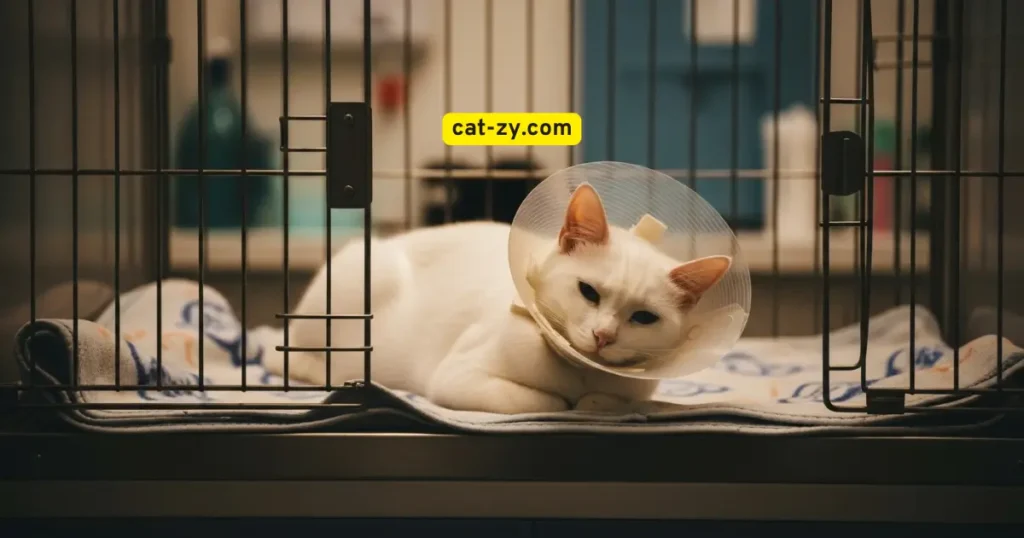
Limiting Movement After Surgery
It’s important to keep your cat still after surgery to avoid problems. A cage is a good place for them to rest. Less movement means fewer risks of complications.
Medication Administration Made Easier
Using a cage makes giving medicine to your cat easier. It keeps them calm, making it simpler for you. This setup helps reduce stress when giving medicine.
Monitoring Health Changes Effectively
Watching your cat’s health closely is another big plus of caging. You can see if they’re eating, vomiting, or showing other signs. This is key for catching any health issues early.
Case Study: Post-Operative Care Success Stories
Many cat owners have seen their pets recover faster with cages. Cats with orthopedic surgery, for example, heal quicker with less movement. These stories show how crucial a controlled recovery space is for your cat’s health.
Learning about the medical benefits of caging cats can help you care for them better. Whether it’s after surgery or when they’re sick, caging can be a big help in their recovery.
Benefit #2: Travel Safety and Reduced Stress
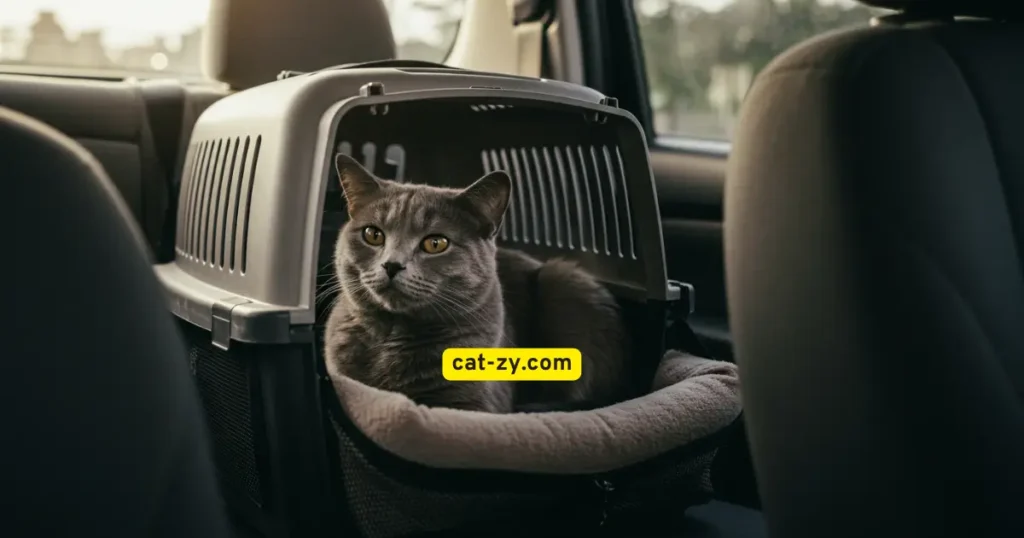
Planning a trip with your cat requires making sure they’re safe and comfortable. Travel can be stressful for cats. But, the cat in a cage approach during travel can help tremendously.
Preventing Escape in Unfamiliar Environments
One big worry when traveling with cats is them escaping in new places. A strong, well-ventilated cage can stop this. It keeps your cat safe and sound.
Creating a Familiar Safe Space Away From Home
Cats love their familiar spots, and a cage can be a cozy, safe place on the road. Add their favorite toys or blankets to make it feel like home.
Reducing Motion Sickness and Anxiety
Motion sickness and travel anxiety are common in cats. A cage limits their movement and offers a snug, enclosed space. This reduces travel stress.
Expert Tips for Stress-Free Travel
To lessen your cat’s travel stress, try these tips: Get them used to the cage before you go. Place the cage in a quiet, stable spot in the car. And only open the cage when you really need to.
By following these tips and using a cage right, traveling with your cat can be much less stressful for both of you.
Benefit #3: Behavioral Training and Modification
Using the cat in a cage method can greatly improve behavioral training. It helps solve many common problems cat owners face. A controlled space makes it easier to change a cat’s behavior.
Litter Box Training for Problematic Cats
Cats with litter box issues can benefit from a cage. It keeps them near a litter box, encouraging use and reducing accidents. This is especially helpful for kittens or rescue cats that need training.
Managing Aggression Between Multiple Cats
In homes with multiple cats, fights can be a big problem. Cages offer a safe spot for shy or aggressive cats. They can escape from stressful situations, lowering tension and preventing fights.
Creating Positive Associations Through Controlled Exposure
Cages also help cats get along with other pets or people. Owners can control the environment, helping cats form good associations. This reduces stress and anxiety.
Success Stories: Before and After Behavioral Intervention
Many cat owners have seen big changes in their pets’ behavior with caging. For example, a cat that was aggressive towards others became calm after meeting them in a cage. These success stories show how caging can help modify cat behavior.
By using caging for training, owners can make their homes more peaceful. This benefits both the owners and their pets.
Benefit #4: Protection for Both Cat and Home
Keeping your cat in a cage helps prevent problems for both your cat and your home. It keeps your cat safe and protects your home from damage. This is because cats can sometimes harm things with their natural behaviors.
Preventing Destructive Behaviors
Cats with lots of energy or curiosity might scratch furniture or chew on things. Putting your cat in a cage when you’re not watching helps. It keeps them from damaging your stuff and gives them something better to do.
Keeping Cats Safe from Household Hazards
Many things in homes can hurt cats, like toxic substances, electrical cords, and sharp objects. A cage keeps your cat away from these dangers. It makes sure they stay safe.
Managing Interactions with Other Pets
Introducing pets to each other can be hard. A cage helps manage these meetings, especially when they first meet.
Creating Safe Introductions to New Environments
When you bring your cat to a new place or introduce them to other pets, do it slowly. A cage lets your cat get used to the new place or pet safely. This lowers stress and the chance of fights.
How to Properly Set Up a Cat in a Cage Environment
A well-set-up cat in a cage environment can greatly improve your cat’s happiness and health. Whether for recovery, travel, or training, the cage’s environment is key. It affects your cat’s comfort and well-being.
Essential Components for Comfort
To ensure your cat’s comfort, the cage needs the basics. Comfortable bedding is essential; use a soft, washable blanket or a cat bed that fits. Good ventilation is also crucial to avoid overheating and keep air fresh. Adding a favorite toy or piece of your clothing can reassure your cat.
Enrichment Activities and Toys
Keeping your cat engaged and stimulated in the cage is vital for their mental health. Interactive toys and puzzle feeders are great for entertainment and challenge. Changing toys regularly keeps things interesting and prevents boredom. Adding catnip or treats can also make the cage more welcoming.
Proper Sizing and Placement
The cage’s size and placement are key. It should be big enough for your cat to stand, turn, and lie down comfortably. Place it in a quiet, draft-free area away from sunlight. This reduces stress and makes the cage a cozy retreat.
Considerations for Cage Size
When choosing a cage, think about your cat’s size and need for movement. Larger cages are needed for bigger cats or extended stays. Smaller cats or kittens might do well in smaller cages, but ensure they have enough room to move.
Duration Guidelines: How Long Is Too Long?
The time a cat should spend in a cage varies by reason. For medical recovery, follow your vet’s advice. For training or behavioral issues, start with short periods and increase as needed. Cats should not be caged for more than 8-10 hours without a break.
By focusing on these points, you can make a cage a comfortable and nurturing space for your cat. The goal is to create a safe and welcoming environment that supports your cat’s well-being.
Potential Drawbacks and How to Mitigate Them
Cat in a cage practices can be beneficial, but they have downsides. If not done right, it can harm your cat’s health and happiness.
Physical Health Concerns
Caging can harm your cat’s health if the cage is too small. Regular exercise and a balanced diet are crucial for your cat’s health. Make sure the cage is big enough for your cat to move around.
Staying in a cage too long can cause health problems like obesity. It’s important to give your cat time outside the cage to play and exercise.
Psychological Impact Considerations
The mental impact of caging on your cat is important. Cats need mental stimulation to stay happy and healthy. Providing toys and engaging activities can help.
Making the cage a cozy place is key. Adding things your cat loves, like a favorite blanket, can help them feel less stressed.
Balancing Containment with Freedom
Finding the right balance between caging and freedom is important. Regularly letting your cat out of the cage under supervision helps keep this balance.
Creating a safe and fun space outside the cage is also important. This encourages your cat to explore and play, reducing their need for the cage.
Signs Your Cat Is Not Adapting Well
Watching your cat’s behavior and health while caged is crucial. Signs they’re not doing well include meowing a lot, pacing, or changes in eating. If you notice these signs, it’s important to change how you cage your cat.
Changing how long your cat is caged, making the cage more interesting, or talking to a vet can help. These steps can solve the problems.
Conclusion: Making the Right Choice for Your Feline Friend
As a cat owner, making informed cat care decisions is key for your pet’s health. Keeping your cat in a cage can help in many situations, like when they’re sick or traveling. Knowing the good and bad of caging can help you choose the best for your cat.
When picking a cat cage, think about what your cat needs. They should feel safe and comfortable. The cage should have good air, be big enough, and have food, water, and a litter box. This way, you can keep your cat safe and happy.
Choosing to cage your cat depends on their specific needs. By looking at the pros and cons, you can decide what’s best for your cat’s health and happiness.
FAQ
What are the benefits of keeping a cat in a cage?
Keeping a cat in a cage helps with medical recovery. It also makes travel safer and aids in training. It protects both the cat and your home.
How long can I keep my cat in a cage?
It depends on the reason. For medical recovery, it’s a few days to a week. For travel or training, it’s shorter. Make sure your cat gets breaks and exercise outside the cage.
What type of cage is best for my cat?
The best cage varies by your cat’s needs. Standard wire cages are versatile. Soft-sided carriers are good for travel. Playpen-style enclosures offer space to move. Multi-level cat condos provide vertical space.
How can I make the cage comfortable for my cat?
Use comfortable bedding and familiar toys. Ensure good ventilation. Add enrichment activities like puzzle toys or scratching posts.
Can caging help with litter box training?
Yes, caging can aid in litter box training. It limits space and helps your cat associate the litter box with its needs.
How do I introduce my cat to a new cage or enclosure?
Start by introducing your cat gradually. Begin with short periods and increase the time. Use treats and familiar comforts to make the experience positive.
Are there any signs that my cat is not adapting well to the cage?
Yes, watch for excessive meowing, pacing, and trying to escape. Also, look for stress signs like hiding or loss of appetite. If you see these, talk to a vet or animal behaviorist.
Can caging help reduce stress during travel?
Yes, a cage or carrier provides a safe space for your cat during travel. It reduces stress and prevents escape.

